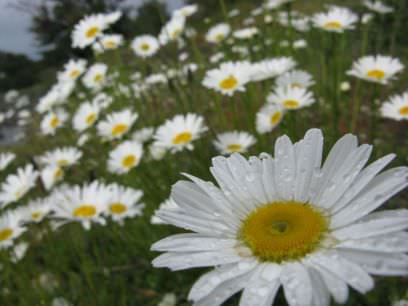So, I got this article published in the January edition of the Patagonia Black Sheep, a monthly magazine available in Punta Arenas, Puerto Natales and other towns in Patagonia. Yay for getting things published! It's about invasive plants. No, that dandelion is not supposed to be here. And neither is that clover. And that scentless chamomile? An outsider as well. These plant species — and a number of others — made their way to Patagonia years ago and, quite literally, put down roots. Some biologists estimate around 25 percent of the plant species in some parts of Torres del Paine National Park originated elsewhere. “Invasive species are going to continue arriving as a consequence of tourism,” said botanist Osvaldo Vidal, author of the guide Flora Torres del Paine and a doctoral student in Germany, speaking in Spanish. “This is clear.”
Scentless chamomile: Cute, but invasive
Many of the invasive grasses and ground covers found in Patagonia were introduced as forage for livestock, and many of the flowers were brought over for ornamentation purposes. Other plants arrived by accident: Their seeds rode into the region in the fur, feathers or intestines of animals, or the shoes, clothing, tents or cars of humans. Most came from Europe. Some of the most common invasive species in Torres del Paine today are: • Poison hemlock • Red sorrel • Scentless chamomile • Silver hairgrass • Spotted catsear Invasive plants have earned a bad reputation in the scientific community for their tendency to change ecological patterns and displace their native counterparts. Few, if any, studies have been conducted to determine the effects of the invaders in Patagonia, however. Morty Ortega, a professor at the University of Connecticut who has conducted research in the park since 1977, said he considers most of the invasive grasses and ground covers in Patagonia more useful than threatening. “Perhaps the most dangerous ones are those that are brought as ornamentals and escape because of their aggressive nature,” he said, citing a fast-spreading, white-flowered plant named cicuta as a prime example. He described the plant as both poisonous and useless. Human visitors, hikers especially, are the single greatest threat to the native Patagonian ecosystem today, Vidal and Ortega agree. In addition to unknowingly spreading seeds, they compact the soil, making it ill suited for fragile native species and ideal for hearty invaders. So as you trek through Torres del Paine National Park this season, do your part to slow the invasion. Stay on established campsites and trails, and wash seeds from your clothes and supplies before you arrive and after you leave. That way, Patagonia can stay Patagonia, and stop evolving into the countryside outside your hometown.

